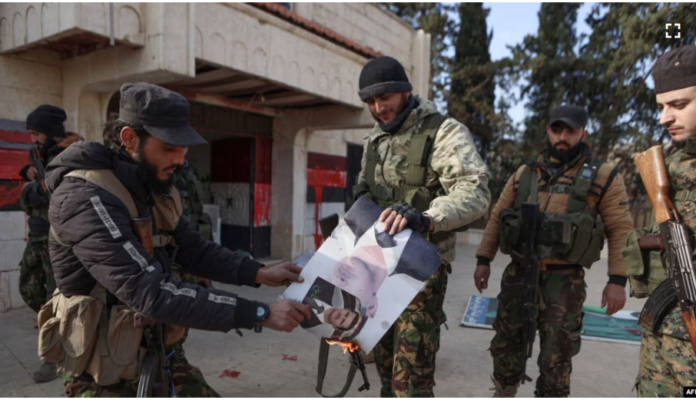Hundreds of foreign fighters are in the ranks of the Syrian militants who seized power and toppled longtime President Bashar al-Assad, RFE/RL has learned.
Videos posted on social media and verified by RFE/RL show Europeans and Central Asians fighting for Hayat Tahrir al-Sham (HTS) during the militant group’s lightening takeover of Syria this month.
Foreigners comprise only a fraction of the overall fighting force of the estimated 10,000-strong HTS and allied groups. But the presence of battle-hardened and radicalized foreign fighters is seen as a risk to Syria’s stability and a security threat in their homelands.
“This will be one of the biggest concerns from a U.S. perspective because they aren’t indigenous Syrians,” said Aaron Zelin, senior fellow at the Washington Institute. “The U.S. is likely less concerned with the Syrians within HTS.”
HTS is a U.S.- and EU-designated terrorist organization that was previously affiliated with Al-Qaeda. The militant Islamist group has pledged tolerance and inclusivity, although concerns remain over its alleged rights abuses and ties to terrorist groups.
‘It Was Suicide’
One video verified by RFE/RL shows an Albanian-speaking fighter standing in front of the Citadel of Aleppo in Syria’s second-largest city. The video was recorded on November 30, the day HTS captured the northwestern city.
In the video, the unidentified man said the militants were fighting to “remove oppression” in Syria, a reference to the brutal rule of Assad, and described the capture of Aleppo as a “great victory.”
The man is seen wearing the insignia of Albanian Tactical, a unit of Xhemati Alban, which is considered a subgroup of HTS and made up of ethnic Albanians mostly from Albania, Kosovo, and North Macedonia.
“It is a well-structured Islamist jihadist group operating under the HTS umbrella,” said Adrian Shtuni, a Washington-based security and radicalization expert.
“Albanian Tactical focuses on specific military skills, including sniper training and explosives, while also providing training for other fighters,” Shtuni added. “This demonstrates a shift from being just combatants to becoming a strategic force within HTS.”
After Syria’s civil war broke out in 2011, hundreds of ethnic Albanians flocked to Syria to join the Islamic State (IS) extremist group and the Nusra Front, the Syrian branch of Al-Qaeda. The Nusra Front was later renamed HTS.
Among them was an ethnic Albanian man from North Macedonia who fought in Syria for four years until 2020 and then returned to Europe.
“I was young, and we were deceived from videos on the Internet,” said the man, who spoke on condition of anonymity for security reasons.
“Then, we came into contact with some people from Turkey and we left for Syria,” added the man, who did not reveal the group he joined. “It was suicide. We barely managed to escape. I’m trying to forget everything and live a normal life.”
North Macedonia’s Interior Ministry said at least four citizens are actively fighting for armed groups in Syria and neighboring Iraq.
Albania estimates around 30 of its citizens are currently in Syria.
Radicalized Foreigners
Eva Dumani was 8 years old when her father, Shkelzen, took her to Syria in 2013 and joined IS.
The whereabouts of Eva, now 19, are unknown, although the orphans and widows of IS militants are often held in camps by rival groups.
Xhetan Ndregjoni, Eva’s uncle, said he speaks to his niece sporadically, “even though she is very reluctant to reveal her exact whereabouts or situation.”
“She writes a word, and then another after some hours or days,” said Ndregjoni, speaking from Albania. “There have been a few times that I wanted to go to Syria and bring her back, but I don’t know if she is under pressure, doesn’t want to leave, or is radicalized.”
Another European who came to fight in Syria is a 35-year-old man from Bosnia-Herzegovina.
The man, who has lived in Syria since 2013, is among the several dozen Bosnians believed to be residing in Syria.
Speaking on condition of anonymity for security reasons, he described himself as a former “hippie” who turned to Salafism, an ultraradical sect under Sunni Islam. He said he moved to Syria to fight the Assad government and help “liberate the people of Syria.”
“I was in several groups,” he said, without specifying. “I think it was easier for me because I had no concept of war.”
The man said he gave up fighting in 2018, marrying a local woman and transitioning to civilian life in the northwestern province of Idlib, a HTS stronghold.
Many Europeans who joined armed groups in Syria were radicalized online or lured by local recruiters. Others were motivated by religious beliefs and the idea of jihad, or holy war. Some were attracted by the money offered by militant groups.
‘Major Trouble’
Another video verified by RFE/RL showed dozens of armed men in military fatigues in the Syrian village of Deir Semaan, the site of a Christian monastery located around 30 kilometers northwest of Aleppo.
One of the men in the video is a Tajik-speaking fighter who claims the group captured the area from “infidels.” The footage was recorded on December 3.
It is unclear to which group the Tajik-speaking fighter belongs. But several smaller militant groups allied with the HTS consist of fighters from Tajikistan, Uzbekistan, and Kyrgyzstan, including Katibat al-Imam al-Bukhari and the Turkistan Brigade.
A Tajik security official, who spoke on condition of anonymity because he was not authorized to speak to the media, said the footage of Tajiks in Syria is “deeply disturbing” and a potential “time bomb.”
“The videos remind us once again that these individuals can come back to Tajikistan one day and cause major trouble here,” the official said.
Among the estimated 400 Tajiks in Syria are believed to be brothers Anvar Isomiddinov and Muhammadjon Isomiddinov, who are both in their 30s. Natives of the village of Chordeh in northern Tajikistan, they left for Syria around 2014.
A relative of the men, who spoke on condition of anonymity for security reasons, said the family lost contact with them several years ago.
“The last time the family spoke with Anvar and Muhammadjon, they pleaded with the brothers to come back,” the relative said. “But they cut off the conversation and never called back again.”







